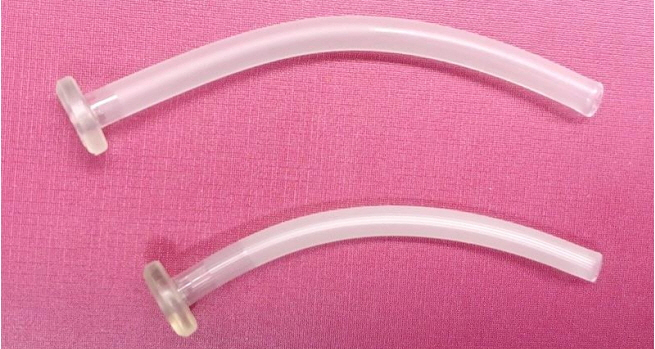Neonatal Med.
2019 Aug;26(3):179-183. 10.5385/nm.2019.26.3.179.
Three Cases of Pierre Robin Sequence with Upper Airway Obstruction Relieved by Nasopharyngeal Airway Insertion
- Affiliations
-
- 1Department of Pediatrics, Jeju National University Hospital, Jeju National University College of Medicine, Jeju, Korea.
- 2Department of Pediatrics, Seoul National University Bundang Hospital, Seoul National University College of Medicine, Seongnam, Korea. pedas@snubh.org
- KMID: 2457187
- DOI: http://doi.org/10.5385/nm.2019.26.3.179
Abstract
- Pierre Robin sequence (PRS), also called Robin sequence, is a congenital anomaly characterized by a triad of micrognathia, glossoptosis, and upper airway obstruction. Infants with PRS can present with varying degrees of respiratory difficulty secondary to upper airway obstruction. There has been no consensus for the treatment of upper airway obstruction in infants with PRS, but recent studies recommend attempting non-surgical interventions before surgical treatment. In this case report, we present 3 cases of infants diagnosed with PRS who showed persistent respiratory difficulties after birth. Before considering surgical intervention, insertion of a nasopharyngeal airway was attempted in these infants. Following this procedure, symptoms of upper airway obstruction were relieved, and all infants were discharged without surgical interventions; the nasopharyngeal airway was removed 1 to 2 months later. To date, no infant has shown signs of upper airway obstruction. Nasopharyngeal airway insertion is a highly effective and less invasive treatment option for infants with PRS. However, it is not widely known and used in Korea. Nasopharyngeal airway insertion can be preferentially considered before surgical intervention for upper airway obstruction in such infants.
MeSH Terms
Figure
Reference
-
1. Cote A, Fanous A, Almajed A, Lacroix Y. Pierre Robin sequence: review of diagnostic and treatment challenges. Int J Pediatr Otorhinolaryngol. 2015; 79:451–64.2. Rathe M, Rayyan M, Schoenaers J, Dormaar JT, Breuls M, Verdonck A, et al. Pierre Robin sequence: management of respiratory and feeding complications during the first year of life in a tertiary referral centre. Int J Pediatr Otorhinolaryngol. 2015; 79:1206–12.3. van Lieshout MJ, Joosten KF, Mathijssen IM, Koudstaal MJ, Wolvius EB, van der Schroeff MP. Non-surgical and surgical interventions for airway obstruction in children with Robin sequence. J Craniomaxillofac Surg. 2016; 44:1871–9.4. Cladis F, Kumar A, Grunwaldt L, Otteson T, Ford M, Losee JE. Pierre Robin sequence: a perioperative review. Anesth Analg. 2014; 119:400–12.5. Gomez OJ, Baron OI, Penarredonda ML. Pierre Robin sequence: an evidence-based treatment proposal. J Craniofac Surg. 2018; 29:332–8.6. Robin P. La chute de la base de la langue considérée comme une nouvelle cause de gêne dans la respiration naso-pharyngienne. Bull Acad Med. 1923; 89:37–41.7. Li WY, Poon A, Courtemanche D, Verchere C, Robertson S, Bucevska M, et al. Airway management in Pierre Robin sequence: the Vancouver classification. Plast Surg (Oakv). 2017; 25:14–20.8. Chang IK, Rhee YW, Lew JD. Pierre Robin syndrome: case report. J Korean Surg Soc. 1969; 11:413–8.9. Lee JW, Park BY. Tongue-lip adhesion using an alveolar protector appliance for management of Pierre Robin sequence. J Korean Soc Plast Reconstr Surg. 2011; 38:547–51.10. Ryu SY, Kwon JK, Kim SK. Mandibular distraction osteogenesis in an infant with Pierre Robin sequence: report of a case. J Korean Oral Maxillofac Surg. 2008; 34:460–7.11. Roberts K, Whalley H, Bleetman A. The nasopharyngeal airway: dispelling myths and establishing the facts. Emerg Med J. 2005; 22:394–6.12. Tweedie DJ, Skilbeck CJ, Lloyd-Thomas AR, Albert DM. The nasopharyngeal prong airway: an effective post-operative adjunct after adenotonsillectomy for obstructive sleep apnoea in children. Int J Pediatr Otorhinolaryngol. 2007; 71:563–9.13. Abel F, Bajaj Y, Wyatt M, Wallis C. The successful use of the nasopharyngeal airway in Pierre Robin sequence: an 11-year experience. Arch Dis Child. 2012; 97:331–4.14. Drago Marquezini Salmen IC, Lazarini Marques I. In situ and home care nasopharyngeal intubation improves respiratory condition and prevents surgical procedures in early infancy of severe cases of robin sequence. Biomed Res Int. 2015; 2015:608905.15. Evans KN, Sie KC, Hopper RA, Glass RP, Hing AV, Cunningham ML. Robin sequence: from diagnosis to development of an effective management plan. Pediatrics. 2011; 127:936–48.
- Full Text Links
- Actions
-
Cited
- CITED
-
- Close
- Share
- Similar articles
-
- Surgical treatment of airway obstruction in infants with Pierre Robin sequence
- Tongue-lip adhesion in Pierre Robin sequence
- Mandibular distraction osteogenesis in an infant with pierre robin sequence: Report of a case
- A two-stage approach to induction and intubation of two infants with Pierre Robin Sequence using a LMA Classic™ and Air-Q®: two cases report
- Endotracheal intubation using a three-dimensional printed airway model in a patient with Pierre Robin sequence and a history of tracheostomy -a case report-



